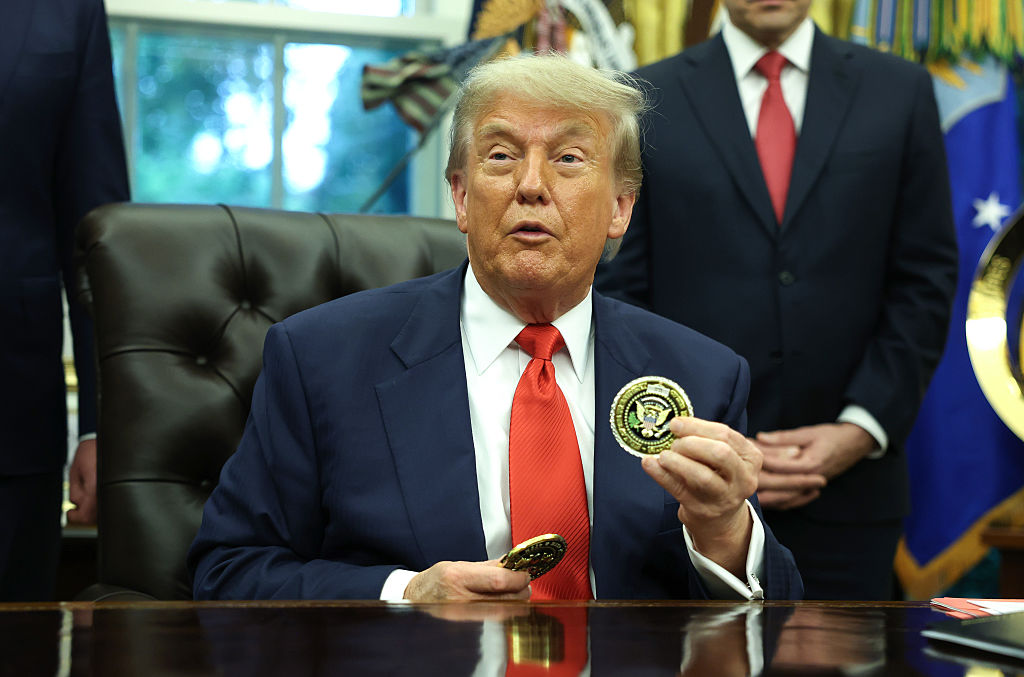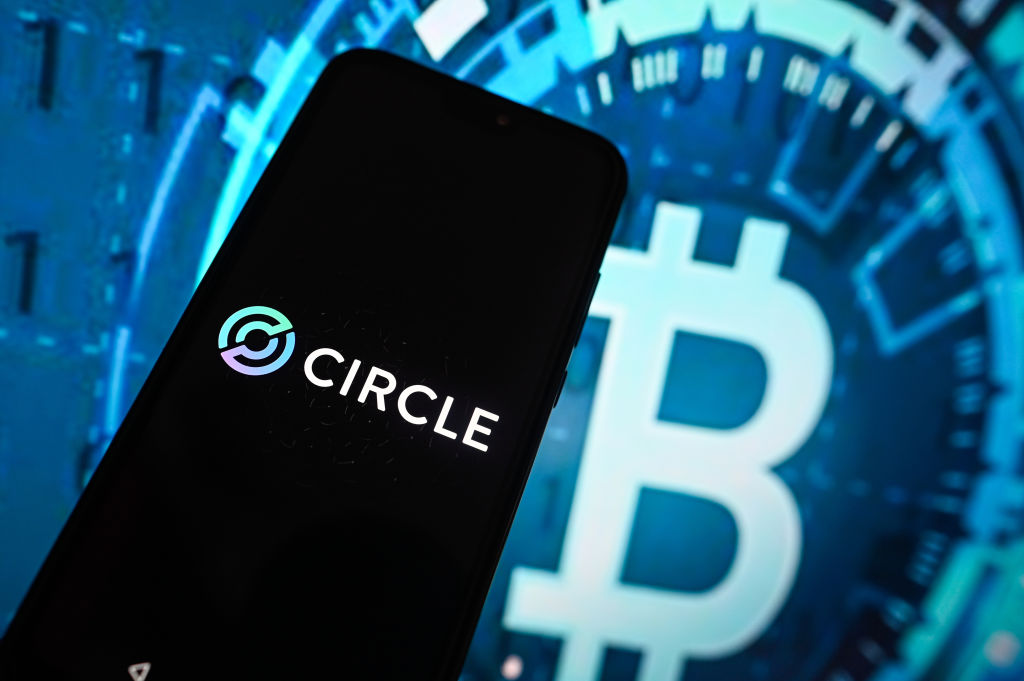How do stablecoins work – and are they risky business?
Stablecoins – cryptocurrencies backed by real assets – are all the rage and have been enthusiastically backed by Donald Trump’s administration. Are they a danger to financial stability?

What’s the point of stablecoins?
Stablecoins – principally tether and circle – are digital tokens run on public blockchains (digital ledgers) whose value is determined not by supply and demand, as with bitcoin, but are backed by a specified asset (such as the US dollar), or basket of assets. Whereas bitcoins are arguably useful as a store of value – albeit a wildly speculative one – stablecoins are genuinely useful when it comes to transactions. The main use of stablecoins is as a safer currency reserve held between trades on cryptocurrency exchanges.
But over the past year – boosted by the enthusiastic backing of the Trump administration – they are increasingly used as a vehicle for sending money anywhere in the world quickly, with low fees, or for trading without wild price swings. Users regard stablecoins as a readily accessible proxy for US dollars that are cheaper and faster than the network of correspondent banks that handle most of the world’s cross-border transactions. With stablecoins, the money is transferred across the internet, outside the banking system, which “makes them highly attractive in countries afflicted by high inflation, weak or volatile currencies, unstable banks or capital controls”, says Philip Stafford in the Financial Times. In Turkey, for example, stablecoin transactions accounted for about 4.3% of GDP in the year to March 2024. Ethiopia is another fast-growing market.
Are all stablecoins pegged to the dollar?
Almost all stablecoins are linked to the world’s most powerful “fiat” currency. But some higher-risk stablecoins are linked to other cryptocurrencies, and others (even riskier) are based on algorithmic trading.
MoneyWeek
Subscribe to MoneyWeek today and get your first six magazine issues absolutely FREE

Sign up to Money Morning
Don't miss the latest investment and personal finances news, market analysis, plus money-saving tips with our free twice-daily newsletter
Don't miss the latest investment and personal finances news, market analysis, plus money-saving tips with our free twice-daily newsletter
This week, a European joint venture that includes Deutsche Bank’s asset-management arm DWS, which manages about a trillion dollars globally, was licensed by the German regulator to issue the first euro-denominated stablecoin.
Here in the UK, BCP Technologies last month launched tokenised GBP (tGBP), the first sterling-denominated stablecoin from a UK-registered issuer to go live. According to the firm, each tGBP token is backed one to one by “reserves held in a segregated account at a UK-regulated financial institution and is fully redeemable for sterling at any time”.
How popular are stablecoins?
There’s currently around $250 billion of stablecoin in circulation, a figure projected (by investment bank Standard Chartered) to grow to $2 trillion by the end of 2028. The number of wallets that regularly send and receive payments hit a record average of 46 million in May, up from 27 million a year before. And according to data firm Chainalysis, total trading, payments and transfers in stablecoins hit $27.6 trillion last year, or two-fifths of all value settled on public blockchains, up from a fifth in 2020. But as the tokens move into the mainstream, critical voices are getting louder. Sceptics argue that they are essentially unregulated bank deposits, with all the risks of failure and systemic contagion that implies. There’s nothing you can do with a stablecoin that “can’t be done more cheaply and more easily with debit cards, Venmo, Zelle, wire transfers and so on, argues economist Paul Krugman on Substack. “Why not just use dollars instead of tokens that are supposedly backed by dollars?”
What’s the answer?
Anonymity – a highly valuable feature for those who want to engage in money laundering, extortion, the purchase of illegal drugs, and so on. For Krugman, stablecoin issuers are “teched-up” versions of 19th-century unregulated banks, which repeatedly experienced panics, bank runs and failure. Indeed, as shadow banks accumulate large reserves of US government debt, they are even more dangerous: a run on stablecoins could turn into a run on US government debt – driving up interest rates in the real economy and causing global panic. In a nutshell, the “growth and legitimation of stablecoins poses new risks to overall financial stability” – all in the name of making life easier for criminals.
Who agrees?
The Bank of International Settlements (BIS) issued a scathing report on stablecoins last month. Society must choose whether to modernise payments sensibly or go down the free-for-all stablecoin route. If it chooses the latter, we will “relearn historical lessons about the limitations of unsound money” that fails “the triple test of singleness, elasticity and integrity”. The BIS advocates the development of a central-bank-based system that “preserves the singleness of money with more efficient domestic and cross-border transactions” and with anti-crime checks, says Chris Giles in the Financial Times. We should wish the central banks well. “It is a race against time.”
Who disagrees?
The US federal government. In January, Donald Trump declared that the US would be “the crypto capital of the planet” and backed “lawful and legitimate dollar-backed stablecoins” as a means of bolstering the dollar’s dominance and demand for Treasuries. Last month, the Senate passed the Genius Act, setting out a notably light-touch regulatory framework for stablecoins. The dangers can be over-egged, says Felix Martin on Breakingviews. Anonymity of transactions is a feature of physical banknotes. Prudential risks are already a concern for money-market funds and traditional banks. And the potential dilution of monetary policy is a “familiar gripe” of central bankers in emerging markets. Regulators are really spooked not by new risks, but by the “frightening scale, scope, and speed which digitisation allows”. Increased oversight would not be all bad for stablecoins, says The Economist, as it would spur interest from mainstream finance companies. Payments firm Stripe recently bought Bridge, a stablecoin-infrastructure start-up. Visa has built a platform to help lenders issue coins. Japan’s Sony Bank is testing its own token for payments, and analysts expect other big banks and Silicon Valley tech companies will also join the fray.
This article was first published in MoneyWeek's magazine. Enjoy exclusive early access to news, opinion and analysis from our team of financial experts with a MoneyWeek subscription.
Get the latest financial news, insights and expert analysis from our award-winning MoneyWeek team, to help you understand what really matters when it comes to your finances.
Simon Wilson’s first career was in book publishing, as an economics editor at Routledge, and as a publisher of non-fiction at Random House, specialising in popular business and management books. While there, he published Customers.com, a bestselling classic of the early days of e-commerce, and The Money or Your Life: Reuniting Work and Joy, an inspirational book that helped inspire its publisher towards a post-corporate, portfolio life.
Since 2001, he has been a writer for MoneyWeek, a financial copywriter, and a long-time contributing editor at The Week. Simon also works as an actor and corporate trainer; current and past clients include investment banks, the Bank of England, the UK government, several Magic Circle law firms and all of the Big Four accountancy firms. He has a degree in languages (German and Spanish) and social and political sciences from the University of Cambridge.
-
 The shape of yields to come
The shape of yields to comeCentral banks are likely to buy up short-term bonds to keep debt costs down for governments
-
 The sad decline of investment clubs – and what comes next
The sad decline of investment clubs – and what comes nextOpinion Financial regulation and rising costs are killing off investment clubs that once used to be an enjoyable hobby, says David Prosser
-
 The steady rise of stablecoins
The steady rise of stablecoinsInnovations in cryptocurrency have created stablecoins, a new form of money. Trump is an enthusiastic supporter, but its benefits are not yet clear
-
 Who is Christopher Harborne, crypto billionaire and Reform UK’s new mega-donor?
Who is Christopher Harborne, crypto billionaire and Reform UK’s new mega-donor?Christopher Harborne came into the spotlight when it emerged he had given £9 million to Nigel Farage's Reform UK. How did he make his millions?
-
 Circle sets a new gold standard for cryptocurrencies
Circle sets a new gold standard for cryptocurrenciesCryptocurrencies have existed in a kind of financial Wild West. No longer – they are entering the mainstream, and US-listed Circle is ideally placed to benefit
-
 Key lessons from the MoneyWeek Wealth Summit 2025: focus on safety, value and growth
Key lessons from the MoneyWeek Wealth Summit 2025: focus on safety, value and growthOur annual MoneyWeek Wealth Summit featured a wide array of experts and ideas, and celebrated 25 years of MoneyWeek
-
 What MoneyWeek has learnt in the last 25 years
What MoneyWeek has learnt in the last 25 yearsFinancial markets have suffered two huge bear markets and a pandemic since MoneyWeek launched. Alex Rankine reviews key trends and lessons from a turbulent time
-
 The MoneyWeek Wealth Summit 2025: how to invest for a volatile era
The MoneyWeek Wealth Summit 2025: how to invest for a volatile eraMoneyWeek's 25th birthday conference’s agenda offers investors a wide array of compelling themes
-
 Who is Rob Granieri, the mysterious billionaire leader of Jane Street?
Who is Rob Granieri, the mysterious billionaire leader of Jane Street?Profits at Jane Street have exploded, throwing billionaire Rob Granieri into the limelight. But it’s not just the firm’s success that is prompting scrutiny
-
 Beware the bubble in bitcoin treasury companies
Beware the bubble in bitcoin treasury companiesBitcoin treasury companies are no longer coining it. Short this one, says Matthew Partridge